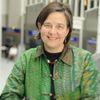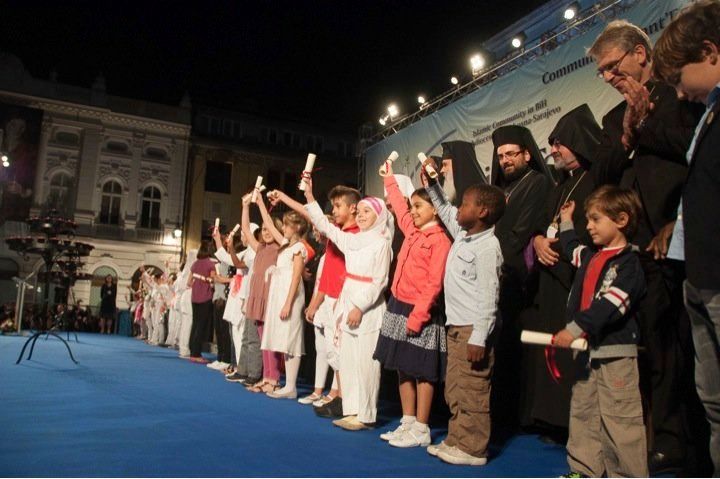
Religious conflict dominates the news today but there's an important and very different story of determined work by religious leaders from all over the world for peace and justice.
Nestled in a valley surrounded by green hills, dainty puffs of clouds drifting across the sky, with cobblestone streets and ancient buildings, Sarajevo at first sight seems an idyllic city. Mosques with graceful minarets, ancient synagogues, and ornate Catholic and Orthodox churches one upon the other are the testimony of a city that long prided itself as a welcome haven for different religions: that diversity should be an asset, not a liability. Mustafa Ceric, Grand Mufti of Bosnia and Herzogovina, never tires of pointing to the ancient Muslim communities of the Balkans as evidence that Europe has deep Muslim as well as Christian and Jewish roots.
But it was in Sarajevo that, in June, 1914 the Austrian Archduke Franz Ferdinand was assassinated, sparking rage and conflicts that rapidly turned tensions into the full horror of the First World War. Then, towards the end of the century, the brutal Balkan wars tore the region asunder. Sarajevo thus marked the beginning and end of a century whose history is in large measure a history of war.
In Sarajevo, vast cemeteries, with graves large and small, scrunched into a city that was under siege, tell the story of this most "modern" war, a conflict that convulsed the city from 1992-1996. It's a reminder that war and violence are not that far off for any community. Buildings still bear the marks of bullets. There's outward peace today in a city that swarms with tourists, but bitter memories seem too close for anything like complacency. Politicians spar over countless issues and Sarajevo's four religious communities - Muslim, Catholic, Orthodox, and Jewish - move, physically, further and further apart.
The annual "Prayer for Peace" organized by the lay Catholic Community of Sant'Egidio takes place each year in a different city. Sarajevo hosted this inspirational gathering from September 8-11. With the theme "Living together is the future", the meeting was blessed with the partnership of the city and nation, and the four main religious communities. Sarajevo's history, its present, and its future became a metaphor for challenges that face the world today: the ironic juxtaposition of real hopes for peace and opportunity for all contrasted with the continuing realities of war, poverty, and injustice.
These meetings take place in the "spirit of Assisi". In 1986 Pope John Paul II invited leaders of major world religions to pray together in the spiritual Italian city of Assisi. They prayed for peace and sought to demonstrate that people with very different religious beliefs could and would respect one another and work together to make the peace that each tradition so earnestly and devoutly professes a reality.
One gathering (like Assisi) has symbolic value but alone brings little change. Thus the Community of Sant'Egidio, whose ethos calls not for tolerance but for true friendship, took on the challenge of making the spirit of Assisi live on, both through their work to broker and build peace in hotspots around the world and to fight underlying causes of conflict: above all poverty and injustice. This community makes extraordinary efforts each year to create an interfaith prayer for peace that is a meaningful event. This year, over two thousand volunteers travelled to Sarajevo to serve as organizers, interpreters, guides, and friends. Truly, as a veteran of countless meetings, I can attest to the fact that there's nothing like this one in terms of human commitment and caring. Every invited guest (some 300 religious leaders and a smattering of others - myself included) has a "guardian angel" who guides them. My angel this year, Massimo Magnano, is an Italian doctor who works (on a volunteer basis) with Sant'Egidio's ambitious HIV and AIDS programs in Africa. He made it his mission to respond to my many questions and put me in contact with anyone I asked. He and his colleagues live an inspiring example of friendship and service.
The Sarajevo event was an intricate blend of substance and symbols.
The substance is real but not easy to capture in a sound-byte. With leaders from all over the world, many meeting for the first time but others long time sparring partners, personal contact and interaction is probably the single most important happening. But then twenty-nine meaty panels tackled an extraordinary range of issues, ranging from "Africa, Land of Opportunities" (my panel), cities and loneliness, immigration and memories and realities of the Balkan wars, Asian religious realities, and religious freedom to the power of prayer. Many of the speeches are available online online. I wish they addressed more issues, like how religious leaders affect relations between men and women and what more they could do to address corruption, but that perhaps is to come. Sant'Egidio's founder, Andrea Riccardi, now the Italian Minister of Development and Integration, is a leading and inspiring public intellectual, his opening and closing speeches are always full of wisdom, insight, and ideas on what needs to be done.
The meeting's symbolism is much easier to describe (and to visualize - witness the attached slide show) than the guts of substantive outcomes. The presence, side by side, of men (yes, men) from previously warring communities, speaking to their pain and determination to reconcile, has great power to move and inspire. Leaders like Italy's Prime Minister Mario Monti who made the effort to come to Sarajevo, as did President of the European Council Herman van Rompuy, attest to the appreciation (hopefully growing) that religious and secular leaders can and must work together. To bring the spirit to the United States, Georgetown University held a simultaneous event reflecting on the significance of Balkan wars and peace.
The miraculous story of the Sarajevo Haggadah was a centerpiece of the opening ceremony. This fourteenth century Jewish document, created in Andalusian Spain, made its way somehow to the Balkans where, twice, courageous Muslims saved the document from destruction, first by the Nazis and second by the fires of the Balkan wars.
The final ceremony is a work of genius in its use of symbolism. People from each religious tradition first pray, separately (message: interfaith dialogue deepens, does not erode one's beliefs and traditions), then come together in a joyful procession to the city's main square. There's a witness to courage and survival: Rita Prigmore, from Germany's Roma (Gypsy) community, gave a frightening and inspiring testimony of suffering and courage). Then a moving appeal for peace is read. Copies are given to a line of adorable children who carry these scrolls to ambassadors and dignitaries. Finally leaders take torches to light giant candelabras and sign the appeal.
The vision of religious leaders affirming their determination to work for peace in a joyful celebration makes for an optimistic, even a euphoric spirit. So it was sobering indeed to learn that even as this final ceremony unfolded crowds were wreaking terrible destruction just across the Mediterranean in Libya. Sobered yes, but hopefully the sequel will be greater determination still. Never have the spirit of Assisi, prayer for peace, dialogue, and the courage of words and action been more vitally called for than they are today.

